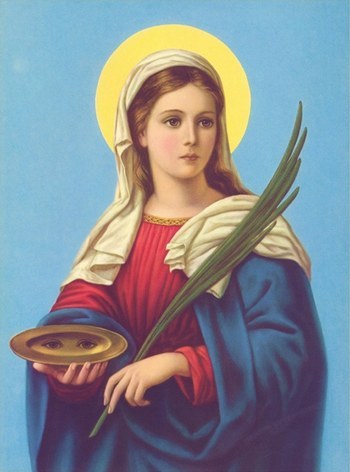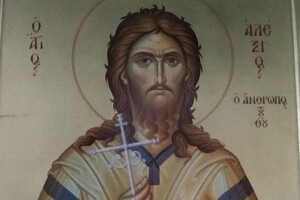Saint Lucia in Corsica - Santa Lucia
Lucia of Syracuse or Saint Lucy
Saint Lucia, also known as Lucia of Syracuse, was born around 283 A.D. in Syracuse, Italy, a port city in southeastern Sicily. She died a martyr under the reign of Diocletian, aged just twenty (303 or 304).
Influence of Saint Agatha of Catania
Born into a wealthy noble family, Lucia of Syracuse lost her father when she was 5, while her mother Eutychia (a name of Greek origin) fell gravely ill a few years later. To help her recover, Lucia of Syracuse took her mother on a pilgrimage to the tomb of Saint Agatha, a Christian saint who died a martyr in 251 A.D. in the town of Catania, some 60 km to the north.
Eutychia's cure
Following her prayer, Saint Agatha is said to have appeared the following night to Lucia of Syracuse, declaring: "Virgin Lucia, my sister, why have you come to ask me for what you will soon be able to grant to your mother? As I have been appointed guardian of the city of Catania, so you shall be appointed guardian of the city of Syracuse". The next day, Eutychia recovered her health, and Lucia promised to devote herself to the poorest of the poor, and to give all her inheritance to the poorest of the poor.
The martyrdom of Lucia of Syracuse
Lucia of Syracuse, who had taken a vow of chastity as a child, broke off her engagement with the man to whom she had been promised by her mother in order to devote herself to the poor. She was arrested and tortured, but never renounced her faith, and was condemned to death. On the stake, Saint Lucy, still singing the praises of Christ, was pierced by a sword through the throat, and a priest came to bring her communion just before she gave up the ghost.
The Eye of Saint Lucia - Popular beliefs
Sources on the life of Lucia of Syracuse indicate that her eyes were gouged out during her martyrdom. Legend has it that she gouged them out herself to discourage her fiancé and any other suitors, while another says that her eyes were so beautiful that her executioner, unable to look at them, made her gouge them out before her martyrdom, which God is said to have restored to her the following night. This is why her portraits often depict her with two eyes in a cup.
These stories gave rise to popular beliefs all around the Mediterranean, as in Corsica, where jewels depicting Saint Lucia's eye were used as good luck charms, in particular to ward off the evil eye - l'ochju.
The end of Roman persecution
The Roman Emperor Constantine put an end to the persecution of Christians in the Roman Empire with the Edict of Milan in 313, shortly after the death of Lucia of Syracuse, whose faith could have been lived freely under the new empire. Her fate was different, however, and Lucia of Syracuse is remembered by Christians as a martyr, today elevated to the rank of Saint by the Catholic Church.
Patron Saint in Corsica
Saint Lucia is the Patron Saint of the city of Syracuse, and her influence has crossed the sea, as several Corsican villages are placed under her protection: Ville di Pietrabugno, Sainte Lucie de Tallano (Santa Lucia di Tallà), Santa Lucia di Mercurio, Santa Lucia di Moriani with churches and chapels dedicated to Sainte Lucie mark the Italian influence in Corsica since, on the contrary, few religious buildings are dedicated to her in the various regions of France except in the south where the fishermen of Marseille kept an eye of Sainte Lucie in their purse for prosperity.
Pilgrimage site at Prezzuna
Saint Lucia's chapel at Prezzuna in the commune of Galéria was, and still is, a place of great devotion to Saint Lucia. Every year, the valley's inhabitants and shepherds flocked to the December 13 procession to celebrate Saint Lucia. They sometimes came from afar, on foot and on an empty stomach, as if to do penance and atone for their sins. Some testified to miraculous cures attributed to Saint Lucia.
Most of the island's churches contain a statue of Saint Lucia.
Saint Lucia is celebrated on December 13
In the old calendar, prior to Pope Gregory's reform, Saint Lucia fell 10 days later, around the winter solstice, hence the Corsican saying "à la Santa Lucia, u soli faci un saltu di gallina" (on Saint Lucia, the sun makes a chicken jump).
A date that also marked the start of the pig slaughtering season, the beginning of a new season for charcuterie.


